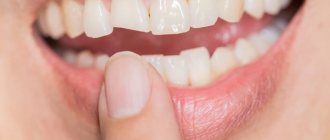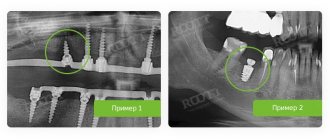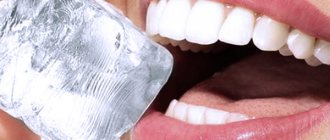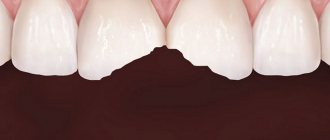What symptoms accompany implant mobility?
There are two possible scenarios:
- there is no inflammation of the tissue around the implant, and it just wobbles, but does not hurt,
- the implant wobbles due to inflammation and pain in the jaw.
Of the possible complications, the first “scenario” is the least dangerous condition, which is most often caused by errors of the specialist installing the structure, and a number of diseases that affect the rate of osseointegration (diabetes mellitus, for example). In this case, the patient simply feels the mobility of the metal rod 2–3 weeks after the operation, the implant wobbles a little. The soft tissues around retain their former natural appearance, there is no pain or change in condition in the oral cavity. This is the most favorable outcome, allowing you to correct the situation with the least damage to your health and wallet.
However, the implant can also wobble due to poor-quality installation, as well as complete failure to engraft into the bone. This situation is not favorable - most likely, the product will have to be removed.
In the second case, mobility against the background of inflammation is a serious symptom that indicates rejection of the structure. And the instability of the structure, as a rule, occurs after the long-term existence of other signs of inflammation:
- the gums around the implant have changed color, become bright red, bluish, unevenly colored,
- there was slight swelling,
- the mucous membrane does not adhere tightly to the artificial structure, partially detaches from its surface,
- when chewing, pain occurs, as well as when touching the gums,
- bleeding gums around the implant,
- the appearance of a putrid odor from the area of the installed implant,
- discharge of pus from under the gums,
- body temperature remains elevated to 39°,
- there is a general malaise.
All these symptoms indicate developing mucositis or peri-implantitis - first superficial, and later deep inflammation of soft and bone tissues.
In both cases, you should not wait for the situation to improve; you should immediately seek professional help. Read more about the unfavorable outcome of implantation in the material “Dental implant rejection.”
How to recognize rejection?
If the implant is rejected, then mobility is not the only and most often not the first symptom. You should worry if:
- Painful sensations arose in the implant area after they subsided in the first 3 days after the operation.
- Swelling or hyperemia has appeared.
- The bleeding, even minor, does not stop for a long time.
- There is pus draining around the implant.
- A putrid smell appeared in the mouth.
If you notice one of these symptoms or, naturally, regarding a dental implant, then try to see your implantologist as soon as possible. He will examine the implant area and prescribe treatment to relieve inflammation. If the treatment process begins on time, as soon as you notice that the tooth-implant is swaying, then rejection can be avoided.
Consequences of implant mobility
A loose dental implant is only a symptom; other problems may arise in the future:
- If you never see your doctor, the entire implant may fall out.
- If peri-implantitis begins, the bacterial infection can spread to other areas and even threaten life.
- If you wait, the bone around the inflamed implant will dissolve, and then it will be very difficult to restore the required height in order to be able to install the implant again.
When it is not the implant that is loose, but the crown on it
How to determine whether an implant or crown is loose? The entire structure, which completely replaces the tooth, consists of several elements - an artificial root, an abutment and a crown that replicates the outer visible part of the tooth. Depending on the type of structure and the method of fastening the crown, the connection of the parts to each other may be different.
Read more about fixing crowns to an implant in the material “How to choose a crown for an implant and which ones are better? Review of modern single prostheses and methods of their fastening.”
It is possible that the screw fastening between the crown and the abutment may loosen or the properties of the cement composition may be lost for a number of reasons. But the implant itself can also become loose. However, at home it is difficult to reliably determine which element has weakened the fixation; this requires assessment and diagnosis by a specialist.
If it turns out that the crown is indeed weakened, then you can return it to its place in the clinic where the implantation was performed. Such cases occur more often with temporary crowns. The doctor will tighten the screw with a special tool and secure it to the implant. When the elements are cemented together, the crown “sits” again after cleaning.
What consequences may there be
Loosening of the implant causes serious complications:
- the titanium rod may completely .
- If the cause of the swing of the dental system is an inflammatory process, then there is a risk of infection spreading to neighboring tissues and even throughout the body, which poses a serious threat to the health and life of the patient.
- If left untreated, inflammation provokes severe bone destruction , which makes it impossible to re-implant an artificial root without bone augmentation.
What causes implant loosening - the main reasons
If a tooth implant begins to wobble, then the reasons for this must be sought in one of three directions. Among them:
- physician errors: rejection due to specialist errors is noted at the initial stage of implantation of the structure (in the first 3–4 weeks) and indicates a poorly performed operation. We will look at possible errors in more detail below.
- systemic diseases and conditions of the patient: they affect the rate of osseointegration or affect the implant that has already taken root. If the cause is disease (periodontitis, hormonal changes during menopause or menstruation in women), then part of the reason for rejection can be considered the shortcomings of the preparatory period on the part of the doctor, who did not take their presence into account. Also, a patient can hide his illnesses from the doctor and, at his own peril and risk, decide to have an operation, the result of which will be rejection. Mobility may occur 5 years or more after implantation due to the appearance or development of systemic diseases, the occurrence of which is difficult to predict,
- patient errors: they are mainly related to the care of installed structures and prevention. By maintaining a level of hygiene for implants and prostheses, the patient creates conditions for their long-term service. Ignoring the requirements can also lead to such unpleasant consequences as inflammation of the tissues around the implants, which, as it progresses, leads first to mobility and then to rejection of the structure.
We must not forget that we are considering exceptional cases of implant mobility and rejection. In general, clinical practice and statistics[1] indicate 2–5% of such cases.
Rejection of titanium dental implants after healing: when does it happen?
The main causes of delayed rejection and instability of implants:
- Peri-implantitis. This inflammation of the surrounding tissues may be a consequence of non-compliance with the protocol or the development of initially undetected weak infectious processes, caries, or the initial stage of periodontal disease.
- Features of bone structure. A small amount of tissue will not hold the embedded pin.
- Pathologies during osseointegration. When choosing a cheap implant from the “no name” series, the pin does not integrate; only scar tissue grows. Fibrosis begins and the structure falls out.
Sometimes the cause of trouble is the treatment of emerging oncological diseases, the use of potent drugs that affect the regeneration of tissue cells.
Implant mobility caused by erroneous actions of the doctor
If the implant begins to wobble during the healing period, for example, a month after installation, then the problem most often lies in the incorrect actions of the doctor while preparing the patient for implantation and directly during the installation operation. Since implantation is a complex undertaking, the doctor may make mistakes at different stages, both at the beginning and directly during the surgical intervention.
During preparation
Receiving false information about the condition of the bone where implants will be implanted. This is possible with insufficient and uninformative diagnosis, when other methods are used instead of computed tomography - orthopantomogram (OPTG) or radiography.
Incomplete preliminary examination (or complete refusal of it) of the patient to determine if he has relative and absolute contraindications that make implantation difficult or impossible. It is also possible that the doctor will not take into account the special hormonal status of women (menopause, postpartum or menstrual period) and will allow surgery during this period without taking into account the condition.
During the preparation of the treatment plan
Incorrect assessment of the place for the implant in the bone, the location of the artificial structure is too close to the roots of living teeth, with insufficient bone tissue.
Directly during surgery
There is a wide scope for incorrect actions: violation of the sterility of instruments and equipment, bacteria entering the prepared hole along with saliva, or when the edge of the implant touches any surface. The use of improperly sized implants, the use of structures for a different surgical protocol, overheating of the bone tissue when forming a bed for the implant, installation of the rod at the wrong angle, excessive deepening of the rod, etc.
For prosthetics
During the manufacture of the prosthesis, violations may occur, resulting in incorrect distribution of the chewing load, inconsistency of the prosthesis with the implants, penetration of the cement composition into the socket, prosthetics of only one row without taking into account the load on the second, and others.
In order not to encounter unpleasant consequences of implantation, a specialist must be chosen carefully, based on many indicators of his work. How not to make a mistake with your choice, read the material “How to choose a doctor and clinic?”
What to do if a tooth implant is loose
See a doctor immediately. He will sanitize the oral cavity and prescribe the necessary studies. Based on the results of the examination, removal of the structure and antibacterial treatment are prescribed. After the inflammatory process disappears, the doctor will prescribe a thorough examination to determine the reasons for the loosening of the structure:
- If rejection occurs due to the patient’s failure to follow the doctor’s recommendations, a doctor’s error or poor quality of the dental system, a repeat implantation operation is prescribed.
- If loosening of the implant is possible due to insufficient volume of the jaw bone, then surgery is necessary to strengthen and build it up.
- If the patient's health deteriorates significantly, re-implantation is not performed. The only way out is removable prosthetics.
In some cases, symptoms of rejection of a dental structure during the healing stage, for example, a putrid odor, are eliminated by temporarily unscrewing the rod plug and cleaning the external elements. This makes it possible to save the implant from removal. The main thing that is required from the patient when a problem is identified is to visit the dental clinic on time; you should not postpone the visit even for a few days, much less weeks.
Opinion of a dental surgeon : “If loosening of the implant in the upper jaw has been detected, it is necessary to urgently consult a doctor. After all, even a slightly wobbly artificial root can injure the bottom of the maxillary sinus. One of the symptoms of such damage is pain that occurs at the wing of the nose. Insufficient primary stabilization can cause implant mobility immediately after it is placed. Shaking of the structure after prosthetics may indicate incorrect adjustment of the prosthesis in height. In this case, the crown distributes the load unevenly, which leads to destruction of the jawbone and mobility of the titanium rod.”
- Complete restoration of the dentition in just 4 days!
more detailsRoott Pterygoid Implants Sinus lift is no longer needed!
more details
Once and for life! Express implantation in 4 days with a permanent ReSmile prosthesis
more details
All-on-4, All-on-6, ReSmile, Zygomatic implantation We use all modern methods of dentition restoration
more details
Systemic diseases and body conditions affecting the fixation of implants
These include chronic diseases that make up the list of contraindications for implantation. They may go unnoticed or deliberately hidden by the patient, or appear much later, when the implant has been standing for several years.
Read about indications and contraindications for implantation in the feature article on the website “When you can or cannot place dental implants - a complete list of tolerances and prohibitions.”
Dental implant failure can occur due to the following diseases:
- diabetes mellitus in a long stage of decompensation,
- pathologies of the central nervous system,
- disruptions in the body's immune system,
- development of oncological tumors of any localization and subsequent therapy,
- allergic reactions in the oral cavity to the components of an implant or prosthesis,
- trauma of the maxillofacial apparatus,
- oral diseases
To avoid unexpected consequences of these diseases, experts recommend regular preventive oral examinations and monitoring of chronic diseases.
Prevention measures
Cleanliness of the oral cavity is of utmost importance to prevent postoperative complications. Good dental hygiene is so important that in some cases, doctors refuse implantation to patients who, in their opinion, are unable to properly care for implant-mounted prostheses.
Poor oral hygiene can not only act as the only cause of complications, but most often it is the provocateur of rejection.
There are special programs that are designed to educate patients about post-implant care. Key points that should be given particular attention include the following recommendations:
- You should brush your teeth with a soft toothbrush at least 2 times a day before bed and after breakfast.
But it is better to brush your teeth after every meal. This ensures the removal of soft plaque from the supragingival areas of implants, superstructures and teeth. You can use electrical appliances. Brushes need to be changed every 2 months. - It is highly advisable to clean the necks of implants and the gingival areas of superstructures with superfloss - dental floss with a porous fleecy working part.
This product allows you to completely remove plaque from the neck of implants, where its presence is critical for the condition of the infrastructure of the prosthesis. - It is recommended to use conical and cylindrical interdental brushes and monotuft brushes. In the gingival area, they are more effective than conventional brushes. Their size and shape are selected individually.
- Experts recommend antiseptic rinses as additional means of cleaning the oral cavity. They are usually used for a short time - immediately after surgery, and for inflammation of microbial etiology.
- For areas closed to other hygiene products, it is useful to use irrigators.
Important. After implantation, you should not use whitening toothpastes containing chlorine or soda.
A preventative visit to the doctor is considered mandatory every 6 months, but more often is better. If, after examining your mouth, your dentist suggests you have a professional cleaning, do not refuse.
The occurrence of implant mobility due to patient negligence
Here it mainly concerns oral hygiene and the rules of care for implants and prostheses installed on them. If the doctor performed the operation competently, taking into account all the patient’s characteristics, then the responsibility for the rehabilitation period falls 90% on the patient’s shoulders. If a dental implant wobbles due to gum inflammation, this indicates an extreme degree of peri-implantitis. Complications at this time and much later are possible for a number of reasons:
- refusal to take medications prescribed by a doctor to restore tissue, prevent inflammation, etc.,
- smoking and drinking alcohol after surgery, unwillingness to give up bad habits in the future. It is known that smokers experience implant rejection twice as often[2] (7% of cases) than those who are not exposed to the bad habit.
- insufficient daily care of dentures and implants, lack of proper hygiene, accumulation of bacterial plaque around implants,
- overload of implants when chewing too hard food, untimely (too early) load on the rods.
All this leads to the development of inflammation and, without treatment, to implant mobility and, ultimately, to rejection of the structure.
Read about the organization of comprehensive oral care after implantation in the thematic material on the website “Care for the oral cavity and dentures after implantation.”
What causes the crown to become loose?
Part of the dental examination is taking an anamnesis, especially if the denture is several years old and you came to a different doctor with a problem than the one who installed it.
The fact is that there are objective reasons for the loosening of crowns.
Dental cement changes its structure over time, and its adhesive (adhesion-promoting) properties are lost. The crowns on the front teeth become loose especially often, because each bite leads to less grip.
Another objective reason is gum recession (loss). With age, the gums sag, covering the roots less and less. A gap forms between the restoration and the gum, where food debris gets in and colonies of bacteria begin to flourish. They destroy hard tissues, the stump becomes smaller, and the prosthesis cannot stay on it.
Therefore, dentists recommend replacing crowns regularly. Most often, a metal-ceramic crown wobbles, because the stump is heavily ground down for it, and the structure itself is massive, with thick walls. The service life of such crowns is the shortest: 5-7 years
. The stronger the material, the thinner the crown, the better the fit, and therefore the longer the service life. Therefore, ceramic restorations and products made from zirconium dioxide can be worn for decades.
But there are other reasons why the crown on a tooth becomes loose.
- Incorrect preparation
The stump for prosthetics must meet certain requirements: slightly taper towards the lower edge, be at least 3 mm in height (4 mm for molars).
If the doctor did excessive grinding, then the crown will slide off the tooth like a slide, even in the presence of cement. There should be a minimum gap between the tooth stump and the walls of the crown. The smaller the gap, the more reliable it is.
Perhaps the tooth was initially short and the doctor did nothing to grow it to the desired size. You can glue the crown, but it will still fall off. The higher the tooth, the better the crown is fixed on it.
The solution to the problem is to build up the stump with composite materials or inlays.
- Problems with cement
Dental materials are expensive and some clinics buy cheap materials from unknown manufacturers. Patients suffer from such savings.
Another case is when the cement is of high quality, but the technology for its preparation has been violated. The adhesive properties of such cement will not be good enough for the prosthesis to last for several years.
When re-prosthetics or re-installation, it is necessary to maintain proportions when mixing cement and use a quality product.
- Violation of manufacturing technology
The quality of the crown depends not only on the orthopedist, but also on the technician who makes it. A qualified technician follows all the requirements for the manufacturing process and always carries out sandblasting. It makes the inner surface rough, and this increases adhesion (adhesion).
Compliance with manufacturing requirements will improve the quality of the prosthesis and extend its service life.
- Loss of hard tissue
Before prosthetics, teeth are often depulped and the nerve (pulp) is removed. Therefore, during caries, the tooth under the crown does not hurt, but it can be destroyed. If caries destroys most of the hard tissues, the crown will begin to wobble, because the volume of the stump will decrease.
The patient himself can understand that the tooth under restoration is inflamed only by the smell from under the crown. In dentistry, for diagnosis, a targeted photograph is used, in which the lesion is visible. After treatment, the orthopedist will build up the stump or use microprostheses before installing the crown. If the tooth cannot be saved, it will be removed. The dentition can be restored with a bridge or implant. Implantation will avoid grinding down adjacent teeth and prevent bone loss. The bridge cannot stop atrophy.
What is an abutment?
An abutment is an adapter head that is screwed to the implant, and on top of which, in turn, a crown (or any other prosthetic structure) is placed. Each implant system has its own set of various standard abutments.
The greater the choice of different configurations and sizes of abutments, the easier it is for the orthopedic surgeon to solve any clinical situation. Expensive popular systems have a wide range of these important spare parts, as they say, for all occasions. And so they are preferable. Therefore, the doctor often makes the choice of an implant system based on what possibilities for prosthetics are provided by a particular manufacturer. Equally important is the degree of accuracy and reliability of the connection between the abutment and the implant.
It's like a construction set, the parts of which must fit perfectly together. The service life of the entire structure largely depends on this. And here, as a rule, the simpler and more budget-friendly the system, the more flaws and design inconsistencies it encounters.











